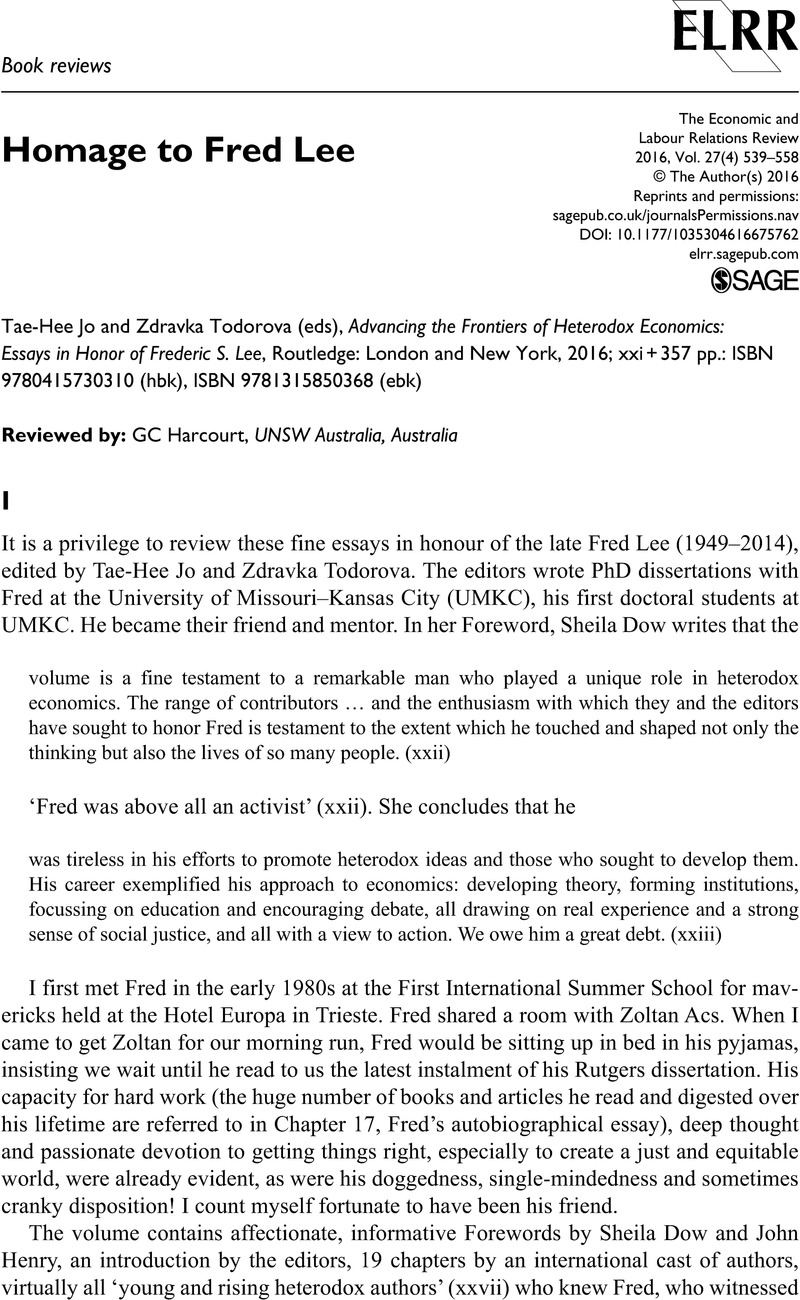No CrossRef data available.
Article contents
Tae-Hee Jo and Zdravka Todorova(eds), Advancing the Frontiers of Heterodox Economics: Essays in Honor of Frederic S. Lee, Routledge: London and New York, 2016; xxi+357 pp.: ISBN 9780415730310 (hbk), ISBN 9781315850368 (ebk)
Review products
Tae-Hee Jo and Zdravka Todorova (eds), Advancing the Frontiers of Heterodox Economics: Essays in Honor of Frederic S. Lee, Routledge: London and New York, 2016; xxi+357 pp.: ISBN 9780415730310 (hbk), ISBN 9781315850368 (ebk)
Published online by Cambridge University Press: 01 January 2023
Abstract
An abstract is not available for this content so a preview has been provided. Please use the Get access link above for information on how to access this content.

- Type
- Book reviews
- Information
- Copyright
- © The Author(s) 2016
References
Bortis, H
(1997) Institutions, Behaviour and Economic Theory: A Contribution to Classical-Keynesian Political Economy. Cambridge: Cambridge University Press.Google Scholar
Dean, E
(2013) Toward a heterodox theory of the business enterprise: The Going Concern model and the US computer industry. PhD Dissertation, University of Missouri–Kansas City, Kansas City, MO.Google Scholar
Elias, N
(2000) The Civilizing Process. Oxford: Basil Blackwell Publishing (originally published as Úber den Prozess den Zivilisation, in two separate volumes in 1939 by Hanszum Falhen, English translation: The History of Manners, 1978, Oxford: Basil Blackwell and State Formation and Civilization, 1982. Oxford: Basil Blackwell).Google Scholar
Goodwin, RM
(1967) A growth cycle. In:
Feinstein, CH
(ed.) Socialism, Capitalism and Economic Growth: Essays Presented to Maurice Dobb. Cambridge: Cambridge University Press, pp. 54–58.Google Scholar
Gruchy, AG
(1987) The Reconstruction of Economics: An Analysis of the Fundamentals of Institutional Economics. New York: Greenwood Press.Google Scholar
Harcourt, GC
(1965) Review of The Theory of Inflation: A Review by AJ Hagger and Inflation and the Theory of Money by RJ Ball. Economic Journal 75(299): 597–598.CrossRefGoogle Scholar
Harcourt, GC
(2012a) On Skidelsky’s Keynes and Other Essays: Selected Essays of G.C. Harcourt. Basingstoke: Palgrave Macmillan.CrossRefGoogle Scholar
Harcourt, GC
(2012b) The Making of a Post-Keynesian Economist: Cambridge Harvest. Basingstoke: Palgrave Macmillan.CrossRefGoogle Scholar
Harcourt, GC and Kenyon, P
(1976) Pricing and the investment decision. Kyklos 29(3): 449–477 (Reprinted in
Harcourt, GC
(1982) The Social Science Imperialists: Selected Essays (ed.
Kerr, P ). London: Routledge & Kegan Paul, pp. 104–126).CrossRefGoogle Scholar
Harcourt, GC and Kerr, P
(1996)
Marx, Karl Heinrich
(1818–83). In:
Warner, M
(ed.) International Encyclopedia of Business and Management. London: Routledge, pp. 3388–3395 (Reprinted in Harcourt, GC (2001) 50Years a Keynesian and Other Essays. London: Palgrave Macmillan, pp. 157–168).Google Scholar
Harcourt, GC and Nolan, PH
(2009) Price theory and multinational oligopoly: Kurt Rothschild and Stephen Hymer revisited. In:
Sanyal, MK, Sanyal, M and Amin, S
(eds) Post-Reform Development in Asia: Essays for Amiya Kumar Bagchi. New Delhi, India: Orient Black Swan, pp. 263–288 (Reprinted in
Harcourt, GC
(2012a) On Skidelsky’s Keynes and Other Essays: Selected Essays of G.C. Harcourt. Basingstoke: Palgrave Macmillan, pp. 156–178).Google Scholar
Harcourt, GC and Riach, PA
(eds) (1997) A ‘Second Edition’ of The General Theory, vol. 1. London: Routledge.Google Scholar
Kalecki, M
(1968) Trend and business cycle reconsidered. Economic Journal 78(310): 263–276.CrossRefGoogle Scholar
King, JE
(2012) The Microfoundations Delusion: Metaphor and Dogma in the History of Macroeconomics. Cheltenham: Edward Elgar.CrossRefGoogle Scholar
Lee, FS
(2004) Predestined to heterodoxy or how I became a heterodox economist. EAEPE Newsletter, July, p. 32 (Reprinted in
Jo, T-H and Todorova, Z
(eds) (2016) Advancing the Frontiers of Heterodox Economics: Essays in Honor of Frederic S. Lee. London: Routledge, pp. 315–319).Google Scholar
Lee, FS
(2009) A History of Heterodox Economics: Challenging the Mainstream in the Twentieth Century. London: Routledge.CrossRefGoogle Scholar
Lee, FS
(2011) Modelling the economy as a whole: an integrative approach. American Journal of Economics and Sociology 70(5): 1282–1314.CrossRefGoogle Scholar
Lee, FS
(2012) Heterodox surplus approach: production, prices and value theory. Bulletin of Political Economy 6(2): 65–105.Google Scholar
Lee, FS
(2013) Heterodox economics and its critics. In
Lee, FS and Lavoie, M
(eds) In Defense of Post-Keynesian and Heterodox Economics: Responses to Their Critics. London: Routledge, pp. 104–132.Google Scholar
Lee, FS
(2014) The role of microeconomics in heterodox economics: A view of a heterodox micro theorist. Unpublished transcript of Fred Lee’s last lecture at the University of Missouri–Kansas City, April 24. Available at: http://heterodoxnews.com/leefs/fred-lee-lecture-at-umkc
Google Scholar
Martins, NO
(2013) The Cambridge Revival of Political Economy. London: Routledge.CrossRefGoogle Scholar
Pasinetti, LL
(2007) Keynes and the Cambridge Keynesians. A ‘Revolution in Economics’ to be Accomplished. Cambridge: Cambridge University Press.Google Scholar
Robinson, J
(1969) The Economics of Imperfect Competition, 2nd ed. London: Macmillan.CrossRefGoogle Scholar
Robinson, J
(1962) Essays in the Theory of Economic Growth. London: Macmillan.CrossRefGoogle Scholar
Robinson, J
(1977) What are the questions? Journal of Economic Literature 15(4): 1318–1339.Google Scholar
Robinson, J
(1979) Thinking about thinking. In:
Robinson, J
Collected Economic Papers, vol. V. Oxford: Basil Blackwell, pp. 110–119.Google Scholar
Shapiro, N
(2012) Competition. In:
King, JE
(ed.) The Elgar Companion to Post Keynesian Economics. Cheltenham: Edward Elgar, pp. 92–95.Google Scholar
Shapiro, N and Mott, T
(1995) Firm-determined prices: the post-Keynesian conception. In:
Wells, P
(ed.) Post-Keynesian Economic Theory. Boston, MA: Kluwer Academic Publishers, pp. 35–48.CrossRefGoogle Scholar
Toporowski, J
(2013) Michał Kalecki: An Intellectual Biography, Vol. 1: Rendezvous in Cambridge 1899–1939. Basingstoke: Palgrave Macmillan.Google Scholar


